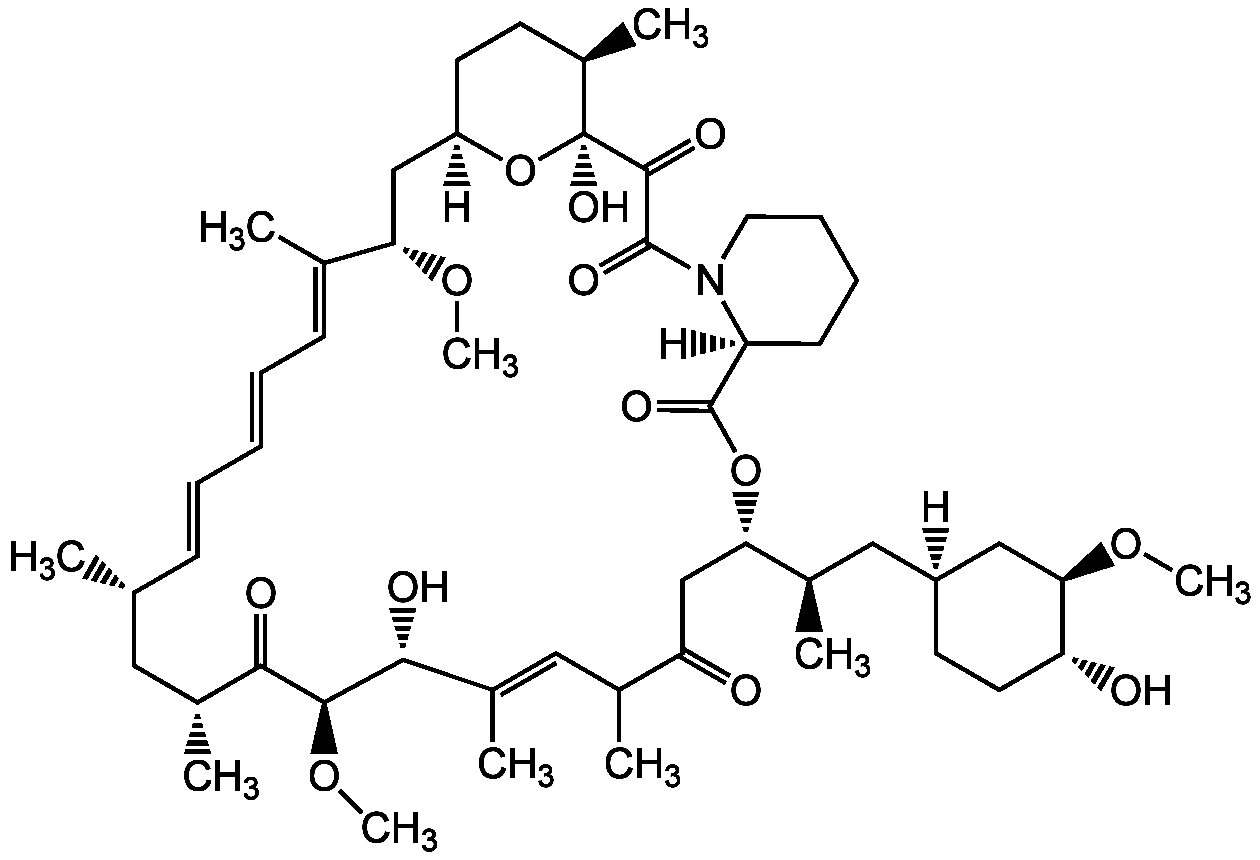Rapamycin
Product Code: AG-CN2-0025
Product Group: Natural Products and Extracts
Supplier: AdipoGen Life Sciences
| Code | Size | Price |
|---|
| AG-CN2-0025-C100 | 100 ug | £30.00 |
Quantity:
| AG-CN2-0025-M001 | 1 mg | £45.00 |
Quantity:
| AG-CN2-0025-M005 | 5 mg | £70.00 |
Quantity:
| AG-CN2-0025-M025 | 25 mg | £160.00 |
Quantity:
Prices exclude any Taxes / VAT
Overview
Regulatory Status: RUO
Shipping:
Ambient
Storage:
-20°C
Images
Documents
Further Information
Alternate Names/Synonyms:
Sirolimus; Rapamune; NSC 226080; Antibiotic AY-22989; WY-090217; RAPA; SILA 9268A; CCRIS 9024
Appearance:
White to off-white solid.
CAS:
53123-88-9
EClass:
32160000
Form (Short):
liquid
InChi:
1S/C51H79NO13/c1-30-16-12-11-13-17-31(2)42(61-8)28-38-21-19-36(7)51(60,65-38)48(57)49(58)52-23-15-14-18-39(52)50(59)64-43(33(4)26-37-20-22-40(53)44(27-37)62-9)29-41(54)32(3)25-35(6)46(56)47(63-10)45(55)34(5)24-30/h11-13,16-17,25,30,32-34,36-40,42-44,46-47,53,56,60H,14-15,18-24,26-29H2,1-10H3/b13-11+,16-12+,31-17+,35-25+/t30-,32?,33-,34-,36-,37+,38-,39+,40-,42+,43+,44-,46-,47+,51+/m1/s1
InChiKey:
QFJCIRLUMZQUOT-KIHCOMIKSA-N
Long Description:
Chemical. CAS: 53123-88-9. Formula: C51H79NO13. MW: 914.2. Isolated from Streptomyces hygroscopicus. Antibiotic. Antibacterial and antifungal properties. Forms a complex with FKBP12 and inhibits the mammalian target of rapamycin (mTOR). Inhibits the response to interleukin-2 (IL-2), and thereby blocks activation of T and B cells. Potent immunosuppressant used as an alternative to calcineurin inhibitors. Restricts the proliferation of smooth-muscle cells by blocking cell cycle progression at the G1/S transition. Anti-proliferative. Antitumor compound. Apoptosis enhancer. Activator of autophagy both in vitro and in vivo. Anti-HIV and anti-aging compound. Neuroprotective. Suppressor for self-renewal and vascular differentiation potential in hemangioma stem cells.
MDL:
MFCD00867594
Molecular Formula:
C51H79NO13
Molecular Weight:
914.2
Package Type:
Vial
Product Description:
Antibiotic. Antibacterial and antifungal properties [1, 2]. Forms a complex with FKBP12 and inhibits the mammalian target of rapamycin (mTOR). Inhibits the response to interleukin-2 (IL-2), and thereby blocks activation of T and B cells [3, 5, 6, 11]. Potent immunosuppressant [4, 10] used as an alternative to calcineurin inhibitors [12]. Restricts the proliferation of smooth-muscle cells by blocking cell cycle progression at the G1/S transition [7, 13]. Anti-proliferative. Antitumor compound [14, 15]. Apoptosis enhancer. Activator of autophagy both in vitro and in vivo [8, 9]. Anti-HIV and anti-aging compound [16, 17]. Neuroprotective [18]. Suppressor for self-renewal and vascular differentiation potential in hemangioma stem cells [19]. mTORC1 inhibitor [20].
Purity:
>98%
SMILES:
[H][C@@]1(C[C@@H](C)[C@@H]2CC(=O)C(C)C=C(C)[C@@H](O)[C@@H](OC)C(=O)[C@H](C)C[C@H](C)C=CC=CC=C(C)[C@H](C[C@@]3([H])CC[C@@H](C)[C@](O)(O3)C(=O)C(=O)N3CCCC[C@@]3([H])C(=O)O2)OC)CC[C@@H](O)[C@@H](C1)OC
Solubility Chemicals:
Soluble in DMSO, methanol or chloroform.
Source / Host:
Isolated from Streptomyces hygroscopicus.
Transportation:
Non-hazardous
UNSPSC Category:
Natural Products/Extracts
UNSPSC Number:
12352200
Use & Stability:
Stable for at least 2 years after receipt when stored at -20°C.
References
Rapamycin (AY-22,989), a new antifungal antibiotic. I. Taxonomy of the producing streptomycete and isolation of the active principle: C. Vezina, et al.; J. Antibiot. (Tokyo) 28, 721 (1975) | Rapamycin (AY-22,989), a new antifungal antibiotic. II. Fermentation, isolation and characterization: S.N. Sehgal, et al.; J. Antibiot. (Tokyo) 28, 727 (1975) | Inhibition of T and B lymphocyte proliferation by rapamycin: J.E. Kay, et al.; Immunology 72, 544 (1991) | FK506 and rapamycin: novel pharmacological probes of the immune response: J.Y. Chang, et al.; TIPS 12, 218 (1991) (Review) | Rapamycin-FKBP specifically blocks growth-dependent activation of and signaling by the 70 kd S6 protein kinases: J. Chung, et al.; Cell 69, 1227 (1992), | Rapamycin inhibition of interleukin-2-dependent p33cdk2 and p34cdc2 kinase activation in T lymphocytes: W.G. Morice, et al.; J. Biol. Chem. 268, 22737 (1993) | A mammalian protein targeted by G1-arresting rapamycin-receptor complex: E.J. Brown, et al.; Nature 369, 756 (1994) | Rapamycin, a potent immunosuppressive drug, causes programmed cell death in B lymphoma cells: S. Muthukkumar, et al.; Transplantation 60, 264 (1995) | Rapamycin enhances apoptosis and increases sensitivity to cisplatin in vitro: Y. Shi, et al.; Cancer Res. 55, 1982 (1995) | Mechanism of action of the immunosuppressant rapamycin: F.J. Dumont & Q. Su; Life Sci. 58, 373 (1996) (Review) | Rapamycin causes poorly reversible inhibition of mTOR and induces p53- independent apoptosis in human rhabdomyosarcoma cells: H. Hosoi, et al.; Cancer Res. 59, 886 (1999) | Rapamycin in transplantation: a review of the evidence: R.N. Saunders, et al.; Kidney Int. 59, 3 (2001) (Review) | Rapamycin in cardiovascular medicine: P.N. Ruygrok, et al.; Intern. Med. J. 33, 103 (2003) (Review) | Rapamycin: an anti-cancer immunosuppressant?: B.K. Law; Crit. Rev. Oncol. Hematol. 56, 47 (2005) (Review) | Tubers and tumors: rapamycin therapy for benign and malignant tumors: D.R. Plas & G. Thomas; Curr. Opin. Cell Biol. 21, 230 (2009) (Review) | Potential use of rapamycin in HIV infection: M. Donia, et al.; Br. J. Clin. Pharmacol. 70, 784 (2010) (Review) | Resveratrol and rapamycin: are they anti-aging drugs? M. Kaeberlein; Bioessays 32, 96 (2010) | Fighting neurodegeneration with rapamycin: mechanistic insights: J. Bov?, et al.; Nat. Rev. Neurosci. 12, 437 (2011) (Review) | Rapamycin suppresses self-renewal and vasculogenic potential of stem cells isolated from infantile hemangioma: S. Greenberger, et al.; J. Invest. Dermatol. 131, 2467 (2011) | Inhibition of the PI3K?Akt and mTORC1 signaling pathways promotes the elongation of vascular endothelial cells: K. Tsuji-Tamura & M. Ogawa; J. Cell Sci. 129, 1165 (2016) | Chemically defined and growth-factor-free culture system for the expansion and derivation of human pluripotent stem cells: S. Yasuda, et al.; Nature Biomed. Eng. 2, 173 (2018) | PtdIns4P on dispersed trans-Golgi network mediates NLRP3 inflammasome activation: J. Chen & Z.J. Chen, Nat. 564, 71 (2018)
Related Products
| Product Name | Product Code | Supplier | FK-506 | AG-CN2-0047 | AdipoGen Life Sciences | Summary Details | |||||||||||||||||||||||||||||||||||||||||||||||||||||||||||||||||||||||||||||||||||||||||||||
|---|---|---|---|---|---|---|---|---|---|---|---|---|---|---|---|---|---|---|---|---|---|---|---|---|---|---|---|---|---|---|---|---|---|---|---|---|---|---|---|---|---|---|---|---|---|---|---|---|---|---|---|---|---|---|---|---|---|---|---|---|---|---|---|---|---|---|---|---|---|---|---|---|---|---|---|---|---|---|---|---|---|---|---|---|---|---|---|---|---|---|---|---|---|---|---|---|---|---|---|
| Everolimus | AG-CN2-0520 | AdipoGen Life Sciences | Summary Details | ||||||||||||||||||||||||||||||||||||||||||||||||||||||||||||||||||||||||||||||||||||||||||||||||



